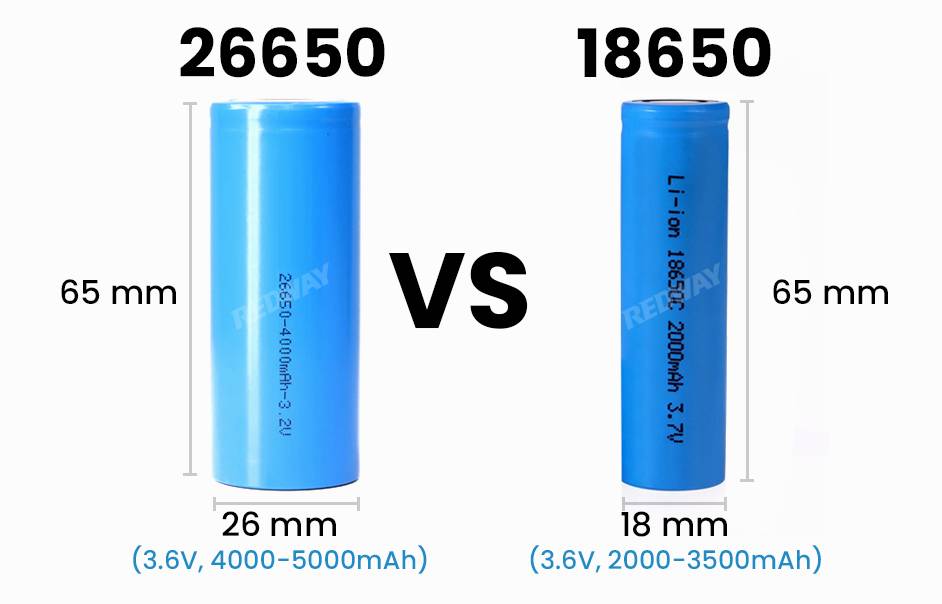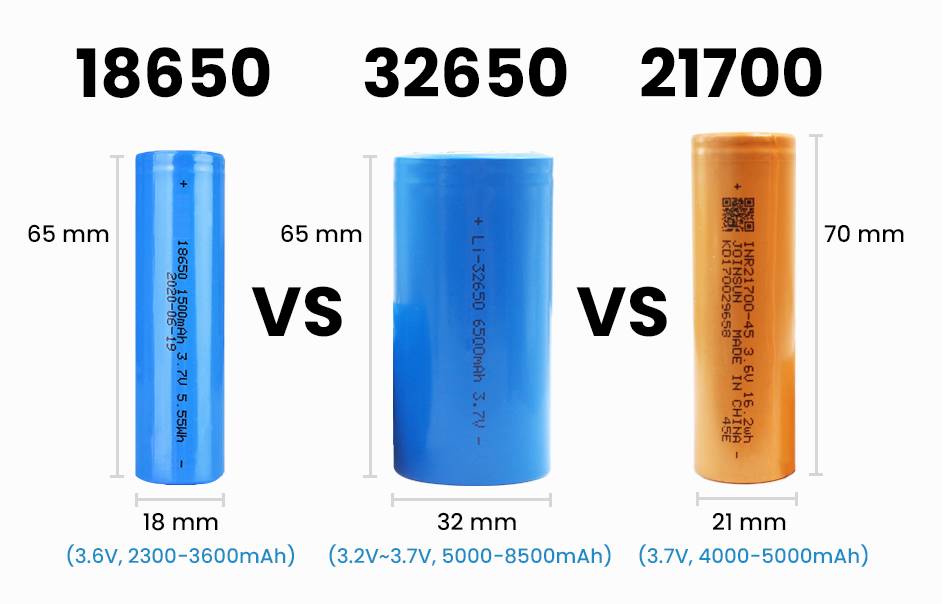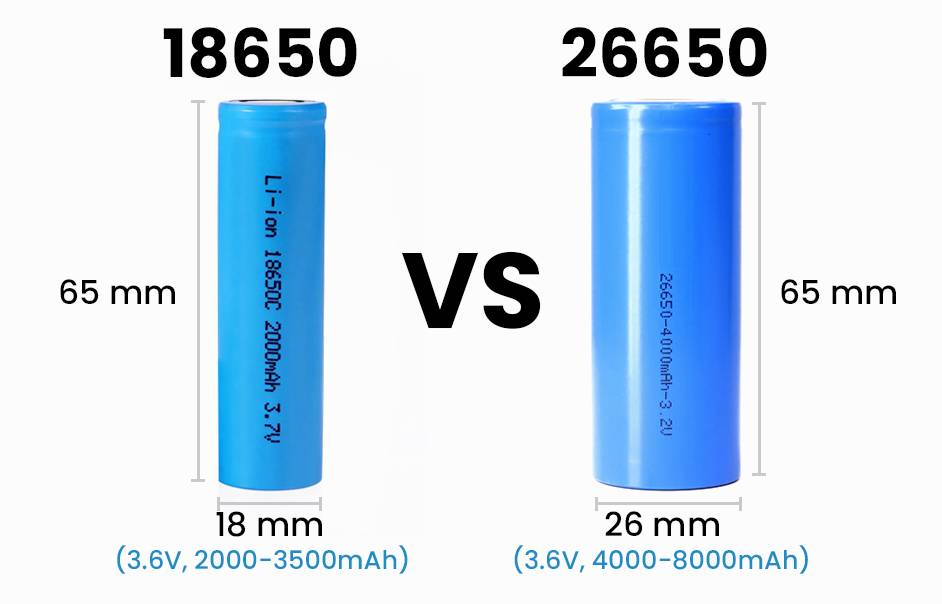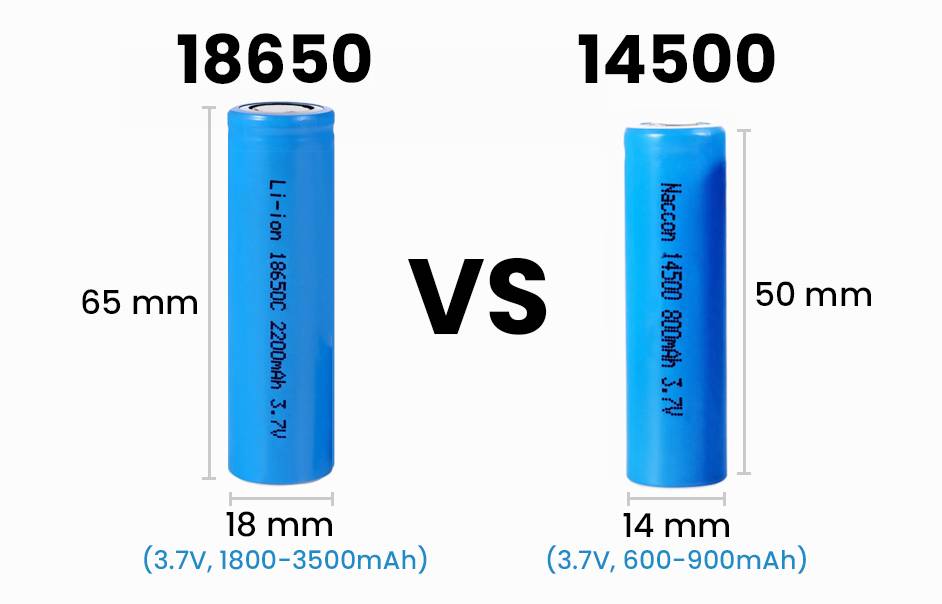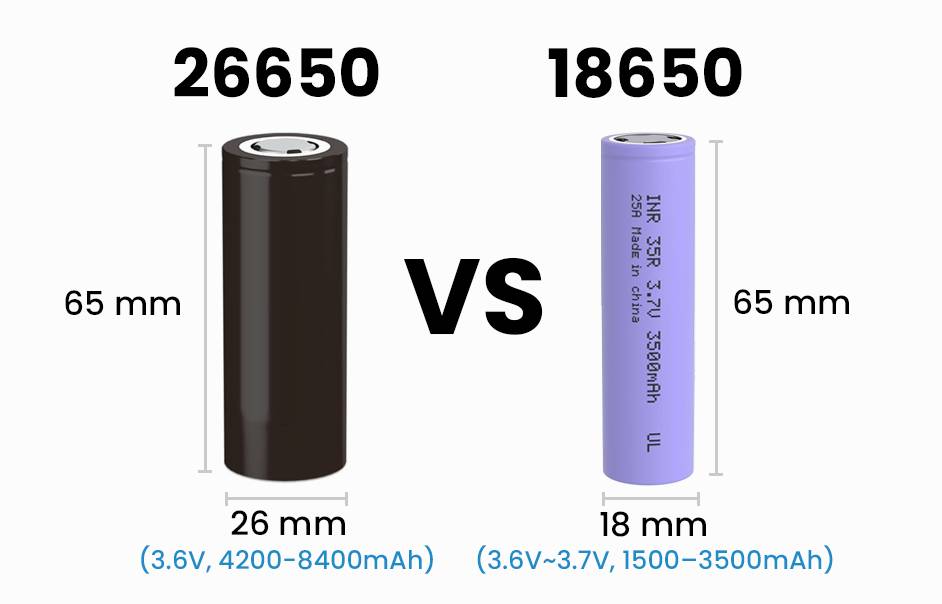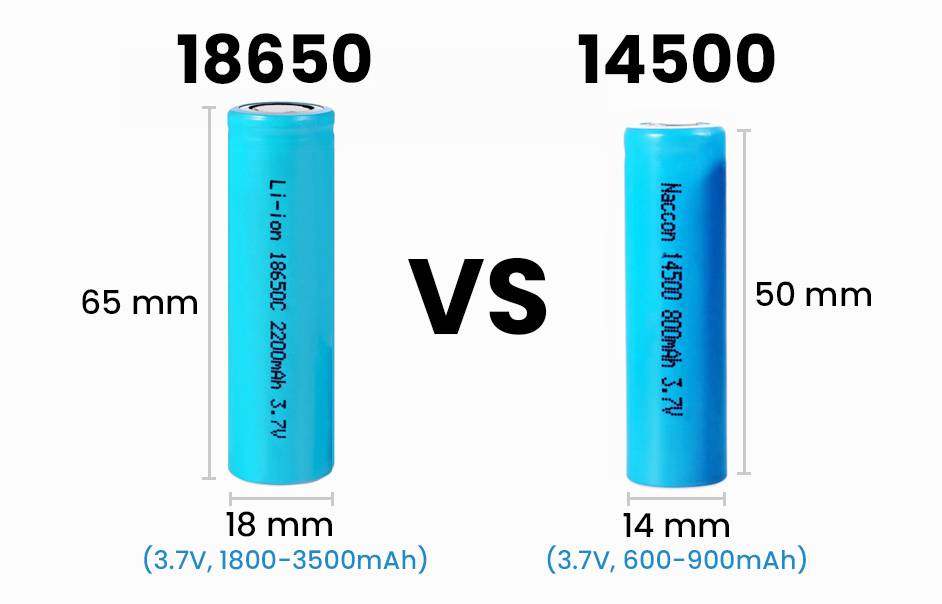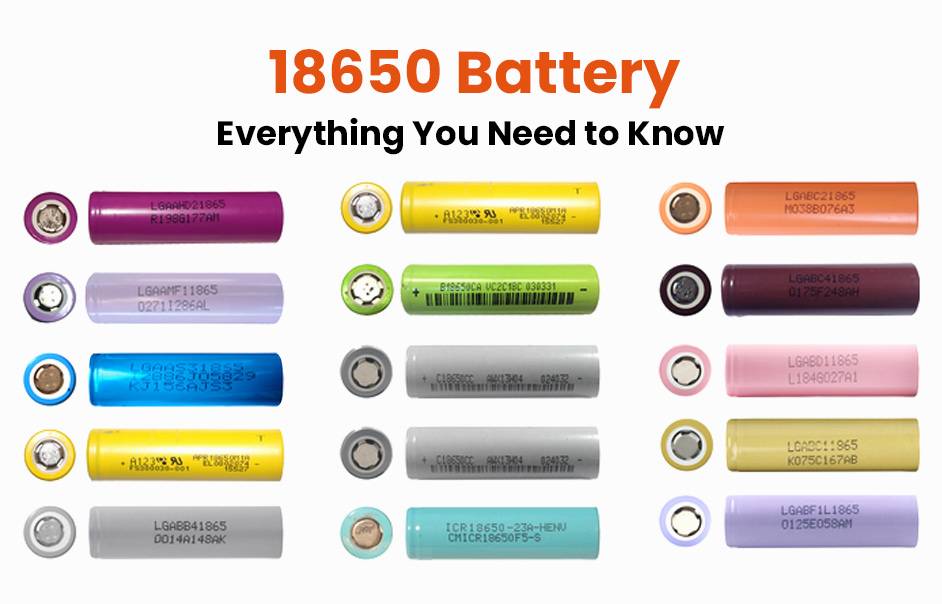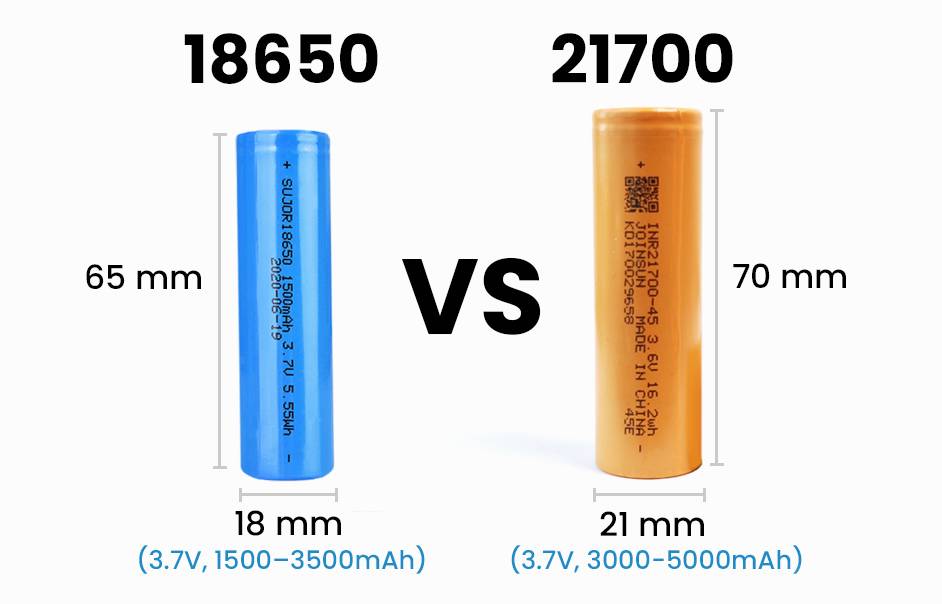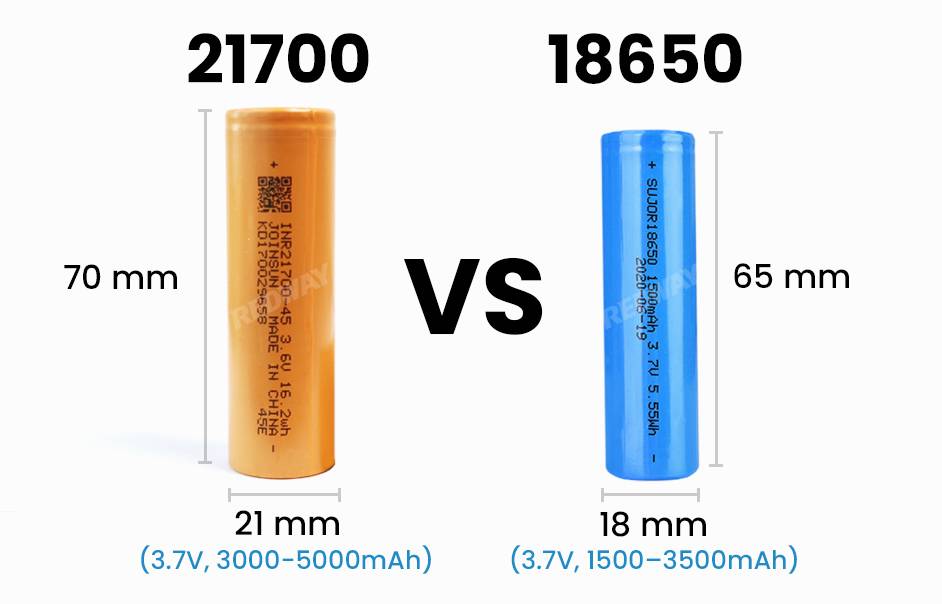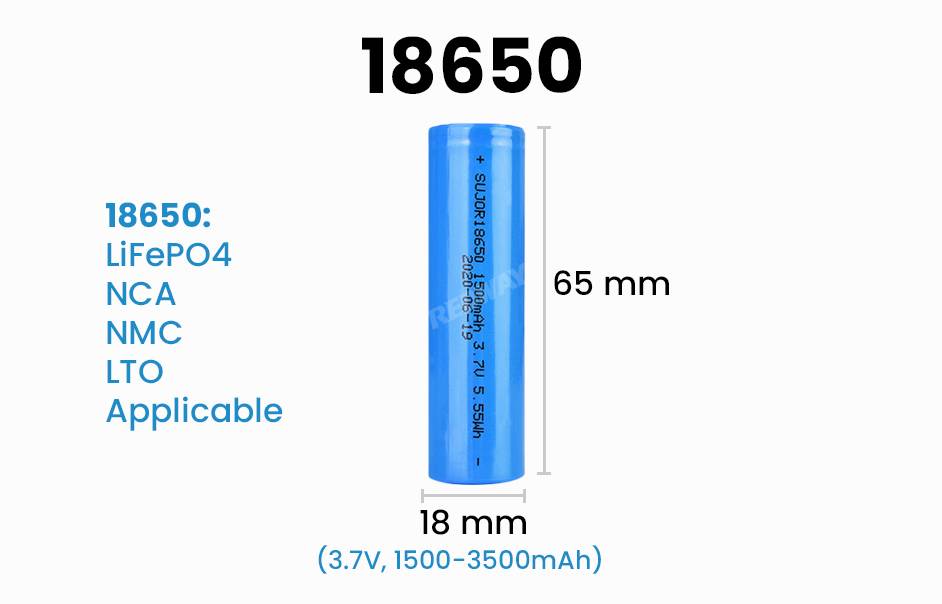Are you tired of carrying heavy batteries that don’t last? Are lithium battery types confusing? Don’t worry! Today, we’re exploring 26650 and 18650 lithium batteries. We’ll cover their size, capacity, performance, and what sets them apart. So, sit back and get ready to learn all about these batteries!
What is 26650 Battery?
The 26650 battery is a rechargeable lithium-ion battery with a diameter of 26mm and a length of 65mm. Larger than the commonly used 18650 batteries, the 26650 variant offers increased capacity and higher current ratings. Its size and performance make it suitable for applications requiring extended power and durability, such as high-powered flashlights, electric vehicles, and portable electronic devices. Known for their robustness and longer runtime, 26650 batteries contribute to efficient energy storage solutions. The larger dimensions allow for a greater energy storage capacity, catering to the demands of power-intensive devices and systems across various industries.
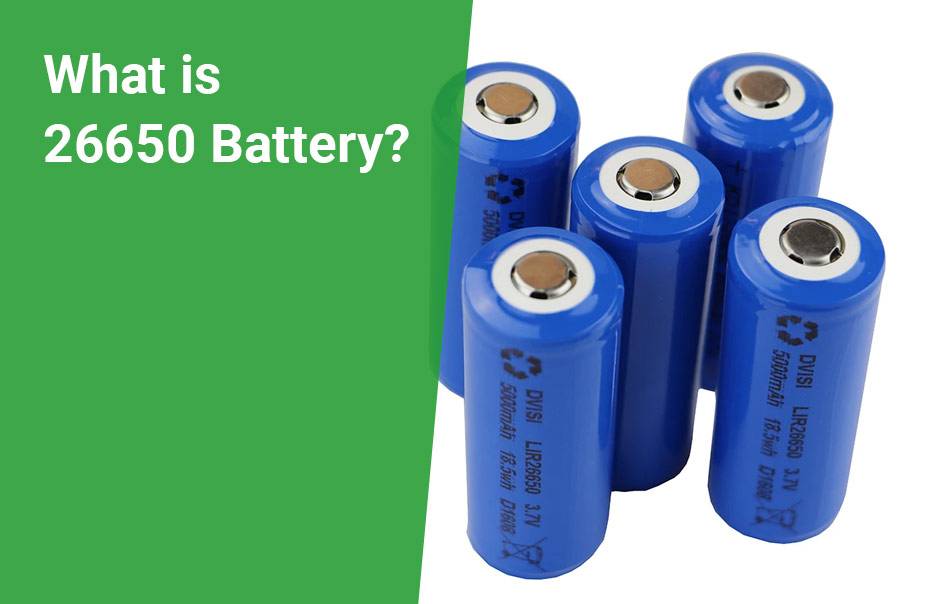
What is 18650 Battery?
The 18650 battery is a widely used rechargeable lithium-ion cell, named for its dimensions of 18mm in diameter and 65mm in length. Renowned for its versatility, these batteries power an array of electronic devices, including laptops, flashlights, and power tools. Their rechargeable nature, standard form factor, and reasonable energy density contribute to their ubiquity. The 18650 design has become an industry standard, allowing interchangeability between devices. With a balance of size and capacity, these batteries are valued for their reliability, making them a common choice in portable electronics and applications where a compact yet powerful energy source is essential.
26650 vs 18650 Battery in size, capacity, and applications
The main differences between a 26650 battery and an 18650 battery lie in their size, capacity, and applications:
Size
26650: The number “26650” refers to the dimensions of the battery, with a diameter of 26mm and a length of 65mm.
18650: Similarly, “18650” denotes a battery that is 18mm in diameter and 65mm in length.
Voltage
26650: 3.6V
18650: 3.6V~3.7V
Capacity
26650: Generally, 26650 batteries have a larger capacity (around 4000 – 5000mAh) compared to 18650 batteries. They can store more energy, making them suitable for applications that require extended use.
18650: While 18650 batteries have a slightly smaller capacity (about 2000 – 3500mAh), they are still widely used and offer a good balance of size and power.
Applications
26650: Due to their larger size and higher capacity, 26650 batteries are often used in applications that demand more energy, such as high-powered flashlights, electric vehicles, and certain power tools.
18650: These batteries are commonly found in a wide range of devices, including laptops, flashlights, vaping devices, and other portable electronics.
Compatibility
26650: Devices need to be designed to accommodate the larger size of 26650 batteries.
18650: 18650 batteries are more compact and are compatible with a broader range of devices.
Ultimately, the choice between a 26650 and an 18650 battery depends on the specific requirements of the device or application. If a larger capacity is needed and the device can accommodate the size, a 26650 battery might be suitable. For more compact devices with lower power requirements, an 18650 battery could be a better fit.
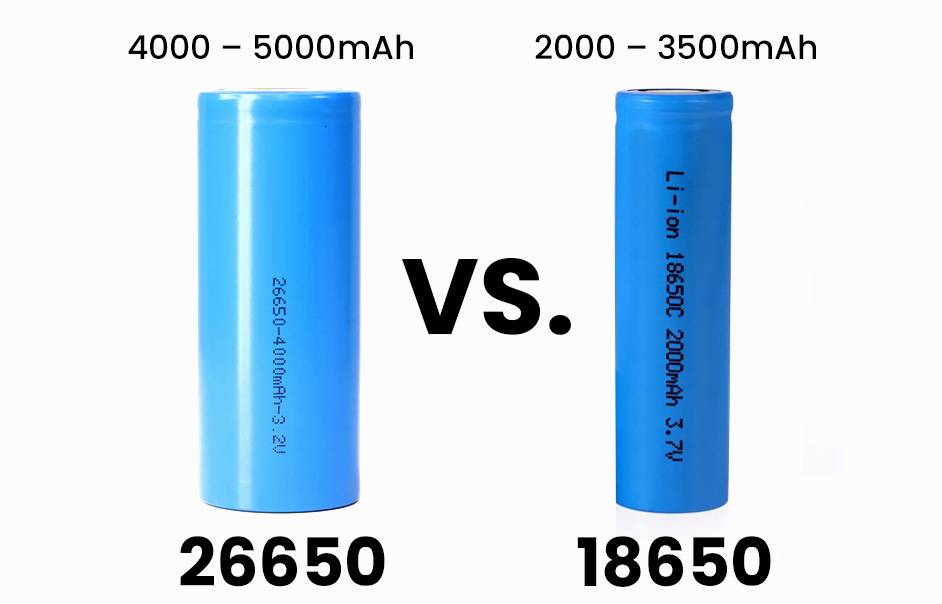
What are some potential disadvantages of 18650 batteries?
Potential disadvantages of 18650 batteries include lower capacity compared to larger battery sizes, limited energy density, and the risk of encountering counterfeit or low-quality batteries in the market.
What advantage does the 18650 battery have over the 26650 battery?
Despite being smaller, the 18650 battery has a higher energy density, delivering a significant amount of power compared to the 26650 battery. The 18650 battery boasts a high energy density, allowing it to deliver a significant amount of power despite its compact size.
What advantages does the 26650 battery have over the 18650 battery?
The 26650 battery offers higher energy capacity and longer runtime compared to the 18650 battery, attributed to its larger size and higher voltage.
How do the energy capacity and energy density of 26650 and 18650 batteries compare?
The 26650 battery typically has a higher energy capacity due to its larger size, while the 18650 battery boasts a higher energy density despite its smaller size.
Can I mix a 26650 battery with an 18650 battery in the same device?
No, it is not recommended to use 26650 and 18650 batteries together in the same device. These batteries differ in size, capacity, and voltage, and using them together could lead to uneven discharge rates, potential damage to the device, or even safety hazards. It’s crucial to use batteries of the same type, size, and specifications as recommended by the device manufacturer to ensure proper performance, safety, and longevity. Always follow the manufacturer’s guidelines and use batteries that are explicitly compatible with your device. Mixing different battery types or sizes can result in unpredictable and potentially dangerous outcomes.
Are 26650 lithium batteries better than 18650 batteries?
The answer is not a simple “yes” or “no” as it depends on the specific requirements of the application.
- If a larger capacity and size are acceptable, and the device can accommodate it, then 26650 batteries might be considered “better” for that particular use.
- Conversely, if compactness and versatility are more critical, 18650 batteries could be deemed “better” for applications with size constraints.
Each type has its advantages, and the choice should be based on the specific needs of the device or system in question.
How to Choose the Right Battery? 26650 vs 18650
If you’re someone who uses a lot of high-drain devices, or if you just want to be sure you’re never left without power, it’s worth investing in a good quality battery. But with so many different types and sizes on the market, how do you know which one to choose? In this article, we’re going to pit two of the most popular batteries against each other – the 18650 vs 26650.
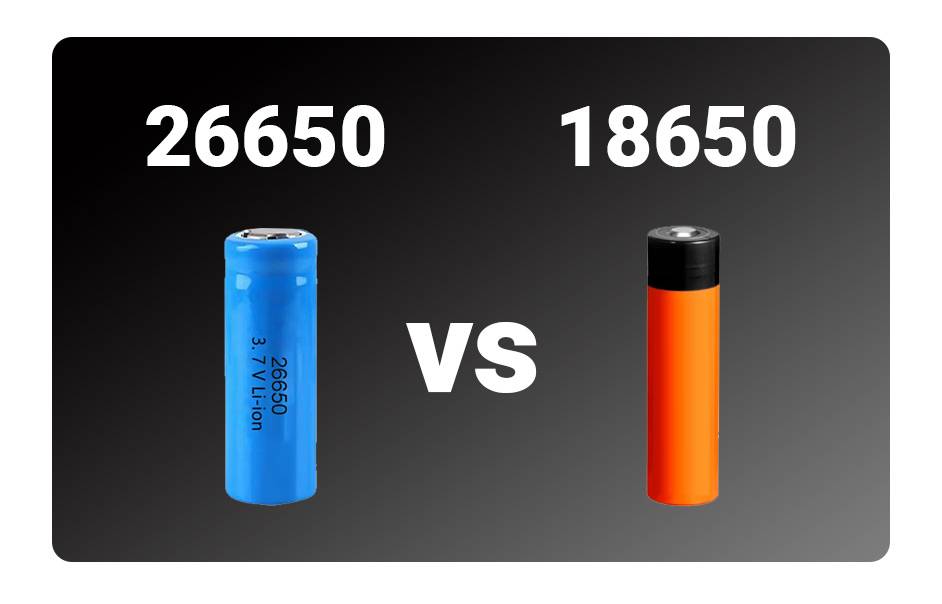 The 18650 battery is by far the most common type of battery used in high-drain devices such as mods and flashlights. They’re also widely used in laptop computers and electric vehicles. 18650 batteries are typically smaller and more lightweight than their 26650 counterparts, making them ideal for use in devices that need to be portable.
The 18650 battery is by far the most common type of battery used in high-drain devices such as mods and flashlights. They’re also widely used in laptop computers and electric vehicles. 18650 batteries are typically smaller and more lightweight than their 26650 counterparts, making them ideal for use in devices that need to be portable.
The 26650 battery is slightly larger and heavier than the 18650, but it offers a higher capacity and therefore longer run-time. This makes them ideal for use in high-powered devices such as box mods, where you need all the power you can get. However, because they are larger and heavier, they’re not as suited to portable devices as the 18650 battery.
When comparing the energy capacity and energy density of 26650 and 18650 batteries, several crucial considerations come into play.
26650 batteries typically offer higher capacity and longer runtime compared to 18650 batteries. This advantage stems from their larger size, allowing them to store more energy for extended use. On the other hand, 18650 batteries, despite their smaller form factor, excel in energy density. This means they can deliver a significant amount of power efficiently, making them favorable for certain applications.
It is important to note that while 26650 batteries shine in energy capacity and runtime due to their larger size, the 18650 batteries’ superior energy density can make them a preferred choice for applications where space and weight considerations are crucial. Ultimately, understanding the differences in energy capacity and energy density between these battery types is essential in selecting the most suitable option for specific needs.
So, which one should you choose? It really depends on your needs. If you want a battery that will give you long run-times and plenty of power, go for the 26650. If you need something smaller and lighter that will still give you.
Conclusion
In summary, both 26650 and 18650 lithium batteries come with distinct pros and cons. Choosing between them should depend on your specific application requirements. The higher capacity of the 26650 battery suits applications demanding high power output or extended run-time, whereas the smaller size of the 18650 battery is ideal for more compact designs. When deciding, consider not only capacity and size but also safety features like temperature control and overcharge protection.
In terms of energy density, some advantages of 18650 batteries include their compact size, relatively high energy density, long cycle life, and compatibility with a wide range of devices. One notable characteristic of these batteries is their impressive energy density, which enables them to deliver substantial power output while maintaining a compact form factor. This high energy density feature of 18650 batteries plays a key role in their effectiveness, allowing them to power various devices efficiently and reliably over extended periods of use.
FAQs
Are 26650 batteries better than 18650?
It depends on your specific needs. 26650 batteries typically offer higher capacity and longer runtime compared to 18650 batteries. However, they are also larger and heavier, which may not be suitable for all applications.
What is the use of 26650 battery?
26650 batteries are commonly used in high-drain devices such as flashlights, power tools, electric vehicles, and other portable electronics where longer runtime and higher capacity are desired.
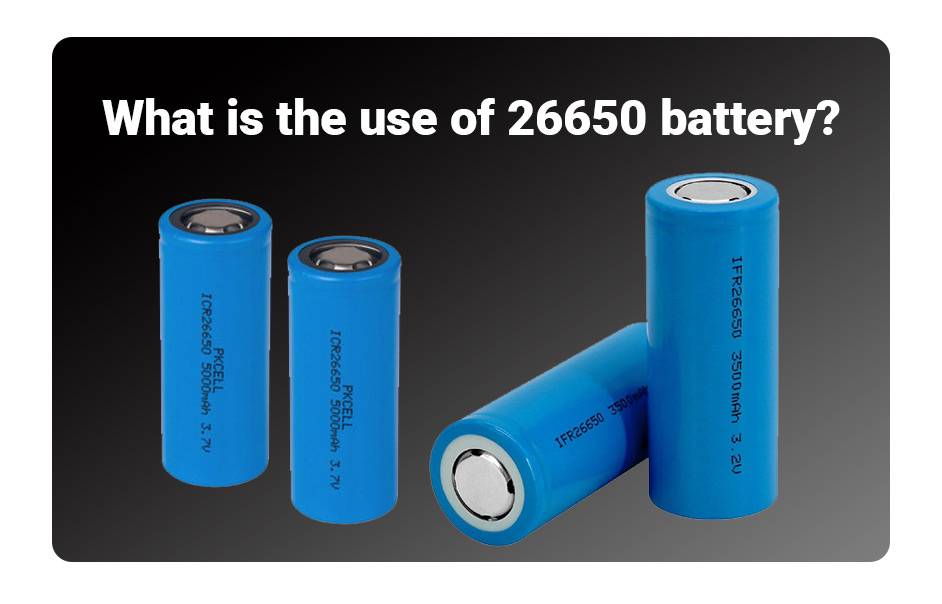
Why are 18650 batteries so popular?
18650 batteries are popular due to their versatility, widespread availability, and compatibility with a wide range of devices such as laptops, flashlights, vaporizers, and power banks.
Can I replace 18650 with 26650?
In some cases, yes, you can replace 18650 batteries with 26650 batteries if the device can accommodate the larger size and higher voltage of the 26650 battery. However, it’s essential to check the device’s specifications and compatibility before making the switch.
What is the best protected 26650 battery?
The “best” protected 26650 battery can vary depending on factors such as capacity, brand reputation, and specific requirements of your device. Some popular brands known for high-quality 26650 batteries include Panasonic, LG, Samsung, and Sony.
What is the difference between a 18650 battery and a 26650 battery?
The main differences between 18650 and 26650 batteries are their size, capacity, and voltage. 26650 batteries are larger, typically have higher capacity, and may provide higher voltage compared to 18650 batteries.
What are the disadvantages of 18650 batteries?
Some potential disadvantages of 18650 batteries include lower capacity compared to larger battery sizes, limited energy density, and the possibility of counterfeit or low-quality batteries in the market.
What is the difference between 18650 and 26650 torch?
The difference between a torch (flashlight) designed for 18650 batteries and one designed for 26650 batteries lies in the size and shape of the battery compartment, as well as the voltage and current requirements of the flashlight.
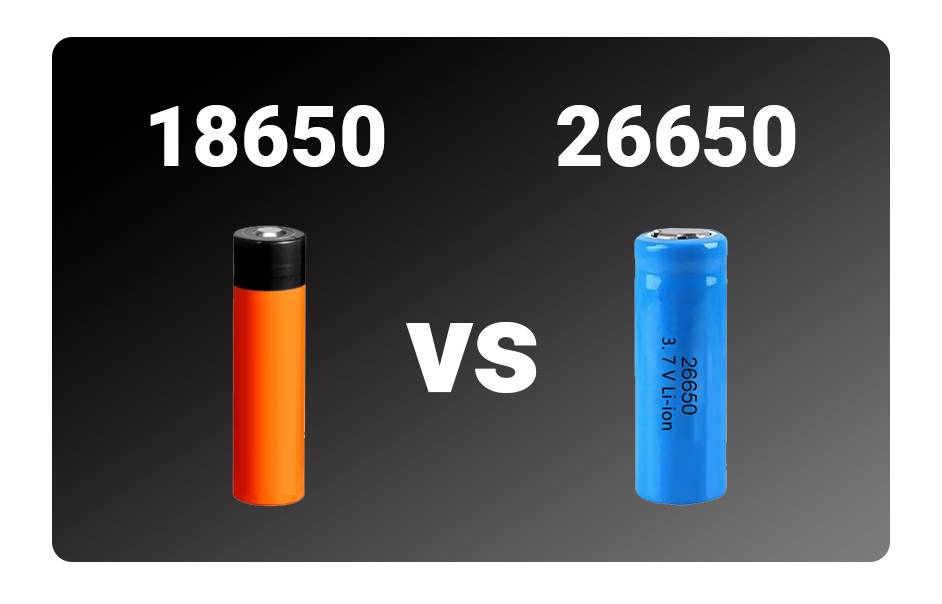
What is so special about 18650 battery?
18650 batteries are special due to their high energy density, versatility, and widespread use in various applications ranging from consumer electronics to electric vehicles.
What are the advantages of 18650 batteries?
Some advantages of 18650 batteries include their compact size, relatively high energy density, long cycle life, and compatibility with a wide range of devices.
What is the full charge voltage of a 26650 battery?
The full charge voltage of a 26650 battery is typically around 4.2 volts. It’s important not to overcharge lithium-ion batteries beyond their maximum voltage to avoid safety hazards.
How do the physical dimensions of lithium-ion batteries impact their performance?
The physical dimensions of lithium-ion batteries play a crucial role in determining their performance. The sizes of batteries like the 26650 and 18650 are not arbitrary; they indicate their diameter and length. Despite seeming like minor distinctions, these dimensions have a significant impact on the batteries’ overall capabilities and utility. With variations in size, factors such as energy capacity, power output, and heat dissipation can be affected. Hence, understanding these physical dimensions is key to comprehending how lithium-ion batteries perform in various applications.
What are the advantages of using a 26650 battery in power-hungry devices?
Using a 26650 battery in power-hungry devices offers several advantages due to its larger size and increased energy capacity. The 26650 battery is larger than its 18650 counterpart, allowing it to store a greater amount of energy. This larger size results in a higher ampere-hour (Ah) rating, indicating the battery’s ability to hold more energy. These advantages make the 26650 battery an ideal choice for power-hungry devices such as high-performance flashlights, vaping devices, and certain electric vehicles. The higher capacity of the 26650 battery enables these devices to operate for longer periods without needing frequent recharging, making them reliable power sources for demanding applications.

What are the critical factors to consider when comparing 26650 and 18650 batteries?
Critical factors to consider when comparing 26650 and 18650 batteries encompass a range of essential aspects. Size, capacity, voltage, and specific application requirements all play pivotal roles in determining the most suitable battery choice. The 26650 batteries, known for their larger and heavier build, excel in providing higher capacity and extended runtime, making them ideal for power-hungry devices like flashlights, power tools, and electric vehicles. Conversely, the 18650 batteries enjoy popularity due to their versatility, widespread availability, and compatibility with a diverse array of gadgets such as laptops, vaporizers, and power banks. To make an informed decision between the two, it is imperative to carefully evaluate the device’s compatibility with the battery size, voltage, and energy demands to ensure optimal performance.
What are the key differences between 26650 and 18650 batteries?
The main differences between 18650 and 26650 batteries are their size, capacity, and voltage. 26650 batteries are larger, typically have higher capacity, and may provide higher voltage compared to 18650 batteries. When comparing the two battery types, it is important to consider additional factors beyond just size, capacity, and voltage. Energy Capacity is a crucial aspect to note, as the 26650 battery generally offers a higher energy capacity due to its larger size. Energy Density is another critical consideration; despite its smaller form, the 18650 battery boasts a higher energy density, allowing it to deliver a significant amount of power efficiently. Moreover, the size and weight of the batteries play a significant role in their usability. The 26650 battery’s larger and heavier build may be a drawback in applications where space and weight are key factors to consider. On the other hand, the smaller 18650 battery’s compact size allows it to fit into a wider range of devices, enhancing its versatility and making it a preferred choice for various applications.

